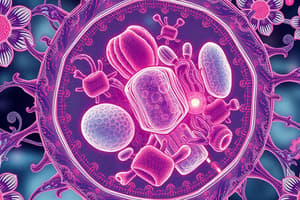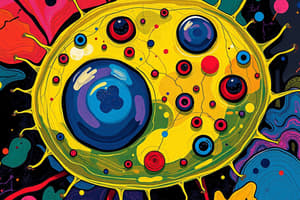Podcast
Questions and Answers
Which statement accurately reflects the Cell Theory?
Which statement accurately reflects the Cell Theory?
- All living cells arise from inorganic compounds.
- All living organisms are composed of one or more cells. (correct)
- All cells can spontaneously create from non-living matter.
- Cells are the only units of living matter on Earth.
What is the main function of ribosomes in a cell?
What is the main function of ribosomes in a cell?
- Site of protein synthesis. (correct)
- Modification and packaging of proteins.
- Production of ATP through respiration.
- Detoxification of harmful substances.
Which type of cell is characterized by the absence of a nucleus?
Which type of cell is characterized by the absence of a nucleus?
- Multicellular cell.
- Eukaryotic cell.
- Prokaryotic cell. (correct)
- Stem cell.
Which of the following describes the fluid mosaic model of the cell membrane?
Which of the following describes the fluid mosaic model of the cell membrane?
What does active transport across a cell membrane require?
What does active transport across a cell membrane require?
What are chloroplasts responsible for in plant cells?
What are chloroplasts responsible for in plant cells?
Which function of the cell membrane involves the selective passage of molecules?
Which function of the cell membrane involves the selective passage of molecules?
Which of the following organelles is known as the powerhouse of the cell?
Which of the following organelles is known as the powerhouse of the cell?
Flashcards are hidden until you start studying
Study Notes
Cell Biology
-
Definition: Study of cells, their physiological properties, structures, organelles, interactions, and behavior.
-
Cell Theory:
- All living organisms are composed of one or more cells.
- The cell is the basic unit of life.
- All cells arise from pre-existing cells.
-
Types of Cells:
- Prokaryotic Cells: Simple, no nucleus (e.g., bacteria).
- Eukaryotic Cells: Complex, with a nucleus (e.g., animal and plant cells).
-
Cell Organelles:
- Nucleus: Contains genetic material (DNA).
- Mitochondria: Powerhouse, produces ATP through respiration.
- Ribosomes: Site of protein synthesis.
- Endoplasmic Reticulum (ER):
- Rough ER: Studded with ribosomes, synthesizes proteins.
- Smooth ER: Lacks ribosomes, synthesizes lipids and detoxifies.
- Golgi Apparatus: Modifies, sorts, and packages proteins and lipids.
- Lysosomes: Contains digestive enzymes to break down waste.
- Chloroplasts (in plants): Site of photosynthesis.
-
Cell Division:
- Mitosis: Somatic cell division for growth and repair.
- Meiosis: Produces gametes for sexual reproduction.
Cell Membrane
-
Structure:
- Composed of a phospholipid bilayer with embedded proteins.
- Fluid mosaic model: Membrane is flexible and proteins can move within the layer.
-
Functions:
- Barrier: Separates the interior of the cell from the external environment.
- Transport: Regulates the movement of substances in and out of the cell.
- Passive Transport: Movement without energy (e.g., diffusion, osmosis).
- Active Transport: Requires energy (e.g., sodium-potassium pump).
- Communication: Contains receptors for signaling molecules (hormones).
- Cell Recognition: Glycoproteins and glycolipids help cells recognize each other.
-
Permeability:
- Semi-permeable: Allows certain molecules to pass while blocking others (e.g., small nonpolar molecules pass easily).
-
Membrane Proteins:
- Integral Proteins: Span the membrane, involved in transport and communication.
- Peripheral Proteins: Attached to the membrane surface, play roles in signaling and maintaining cell shape.
Cell Biology
- Studies the physiological properties, structures, organelles, interactions, and behavior of cells.
- Cell Theory posits that:
- All living organisms consist of one or more cells.
- The cell is the fundamental unit of life.
- New cells arise only from pre-existing cells.
Types of Cells
- Prokaryotic Cells:
- Simple structure, lacking a nucleus.
- Example: Bacteria.
- Eukaryotic Cells:
- More complex structure, containing a nucleus.
- Examples: Animal and plant cells.
Cell Organelles
- Nucleus:
- Houses genetic material (DNA).
- Mitochondria:
- Known as the powerhouse of the cell; responsible for ATP production through respiration.
- Ribosomes:
- Sites where protein synthesis occurs.
- Endoplasmic Reticulum (ER):
- Rough ER: Studded with ribosomes, primarily synthesizes proteins.
- Smooth ER: Lacks ribosomes; involved in lipid synthesis and detoxification processes.
- Golgi Apparatus:
- Modifies, sorts, and packages proteins and lipids for secretion or use within the cell.
- Lysosomes:
- Contain digestive enzymes for breaking down waste materials.
- Chloroplasts (found in plants):
- Sites of photosynthesis.
Cell Division
- Mitosis:
- Type of somatic cell division aimed at growth and tissue repair.
- Meiosis:
- Process producing gametes for sexual reproduction.
Cell Membrane
- Structure:
- Composed of a phospholipid bilayer with embedded proteins.
- Described by the fluid mosaic model, highlighting flexibility and protein mobility.
Functions of the Cell Membrane
- Barrier:
- Distinguishes the internal environment of the cell from the external surroundings.
- Transport:
- Regulates the ingress and egress of substances.
- Passive Transport:
- Movement of molecules without energy (e.g., diffusion, osmosis).
- Active Transport:
- Requires energy input for substance movement (e.g., sodium-potassium pump).
- Communication:
- Contains receptors for signaling molecules such as hormones.
- Cell Recognition:
- Glycoproteins and glycolipids facilitate inter-cell recognition.
Permeability
- Semi-permeable:
- Allows select molecules to permeate while restricting others, notably enabling small nonpolar molecules to pass easily.
Membrane Proteins
- Integral Proteins:
- Span the membrane; critical for transport and communication functions.
- Peripheral Proteins:
- Attach to the membrane's surface; involved in signaling and structural support of the cell.
Studying That Suits You
Use AI to generate personalized quizzes and flashcards to suit your learning preferences.




